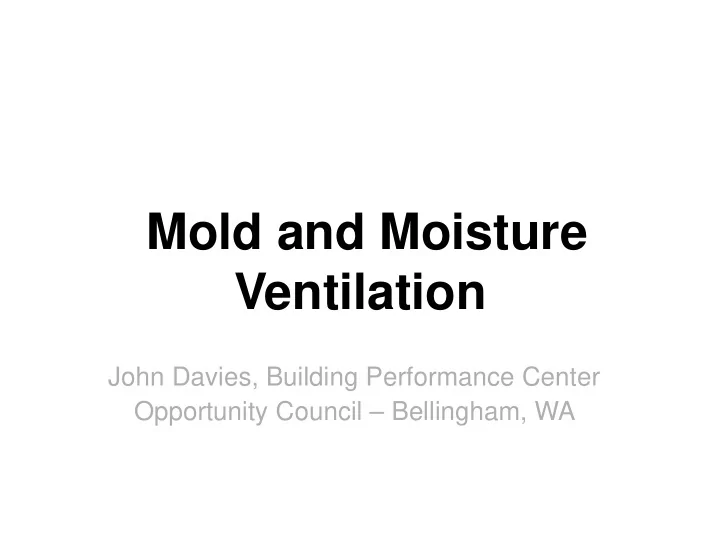

RELATIVE HUMIDITY FACT: Warm Air Can Hold More Moisture Than Cold Air TEMP. R.H.
Pyschrometrics Indoors outdoors • 70 degree air • 40 degree air • 60% Relative • 90% Relative Humidity Humidity • Dew point 54 • Dew Point 36 degrees degrees • 66 grains of • 33 grains of moisture /pound of moisture/pound of air air
1/2 air change • 1/2 the volume has • 50 grains/lb at 70 66 grains/lb degrees =? RH • 1/2 the volume has 33 grains/lb = 45 %Relative • Mixed together air Humidity has 50 grains/lb
40 0 F 75 75 0 F 100 00 % 30 30 % RH RH R H R H Buildings can be dried out by ventilating with cool outside air, even when outdoor relative humidity is high
COLD OUTSIDE DEW POINT Cool window surface High relative humidity on and near cool surfaces
Condensation or leak?
Condition 4 Basement Mold Why the mold? • Cold surfaces causing condensation? • Exterior water source? Do not insulate or cover until moisture problem is dealt with!
Condition 4 Moisture Flows … WARM COLD less MORE
Condition 4 Mold Grow th MOISTURE – Excessive Humidity Warm Humid air + cold surface = condensation Hot Climate outside warm humid air + cold surface on inside wall Cold Climate inside warm moist air + cold surface on outside wall
Condition 4 High Humidity – Window Condensation The lower the window R-value the cooler the inside surface and greater chance of condensation. Mold growth
High humidity – Condition 4 Poor/No Ventilation Is the exhaust fan working properly? Is the exhaust fan vented to the outside? Is the fan operating long enough to remove moisture?
Condition 4 Mold Grow th 4. Building Tightness Since the mid 1970’s homes are built tighter, better weatherized and save energy! Without controlled ventilation … …tighter = less air exchange …tighter = less moisture evaporation …tighter = less pollutant dilution …tighter = greater chance of mold growth
Condition 4 Mold Grow th Building Tightness How tight is too tight? Use Blower Door and Consider: • number of occupants • volume of air conditioned area • mechanical ventilation
Condition Mold Grow th Home Occupant Aw areness Alert occupants of home mold growth and possible conditions that may create moisture problems and mold growth.
Assessing the problem • Pollutants • Pathways • Driving Forces
QuickTime™ and a decompressor are needed to see this picture. Moisture as a pollutant
Pathways
Crawlspace / attic connection Attic Crawlspace Molds and Fungi
Leaky Ducts
Condition 4 Avoid negative pressures in the south (hot and humid) Infiltration of warm, humid air: • Into walls • Through chases • Into rooms Condensation on cool surfaces
WX Building Assessment FOLLOW YOUR NOSE! FOLLOW YOUR EYES! If you can see it or smell it, molds are likely present
Tools QuickTime™ and a decompressor are needed to see this picture.
QuickTime™ and a Photo - JPEG decompressor are needed to see this picture.
Moisture content QuickTime™ and a decompressor are needed to see this picture. QuickTime™ and a decompressor are needed to see this picture.
Humidity and Temp QuickTime™ and a decompressor are needed to see this picture.
Testing for Mold let clients know … • No Federal Threshold Mold Limits or Standards • No criteria or requirements for inspectors • False negative evaluation – Compare quantity and types at various locations – Compare to outside types and levels • Quality mold testing requires special training, special equipment, is expensive AND is not the job of weatherization
During cleanup protect yourself • When cleaning up rodent waste and habitat always use a HEPA vacuum HEPA Vac • Wear personal protection and cleanup as you go
Personal Protection Equipment • Less than 10 sq. ft. – N-95 respirator, gloves, goggles • Between 10 and 100 sq. ft. – N-95 or half face respirator with HEPA filter, gloves, disposable overalls, goggles • Greater than 100 sq. ft. – Full-face respirator with HEPA filter, gloves, disposable full body clothing, head gear, foot coverings and containment
Persistent Mold Growth
Typical Eave Vents
Attic Eave Vent = “wind washing of insulation” Cold ceiling surface in room below
The case of the toilet and the rotting floor • 70 degree air • 55 % RH • Dew point 54 degrees QuickTime™ and a decompressor are needed to see this picture. • Water temp 50 degrees
Solution • Warm the water??? • Insulate the tank • Lower the humidity – Exhaust fan with low flow continuous with QuickTime™ and a decompressor are needed to see this picture. a bumb
Case Study: Michigan City, Indiana • 850 ft.², two bedroom, one bath house • Four occupants • No existing mechanical ventilation • 125,000 btu/h draft hood equipped furnace located in a basement • Pre-Wx: 1100CFM50 • Wx Auditor called for a new 90% efficient furnace and for mechanical ventilation to be installed in the
Recommend
More recommend